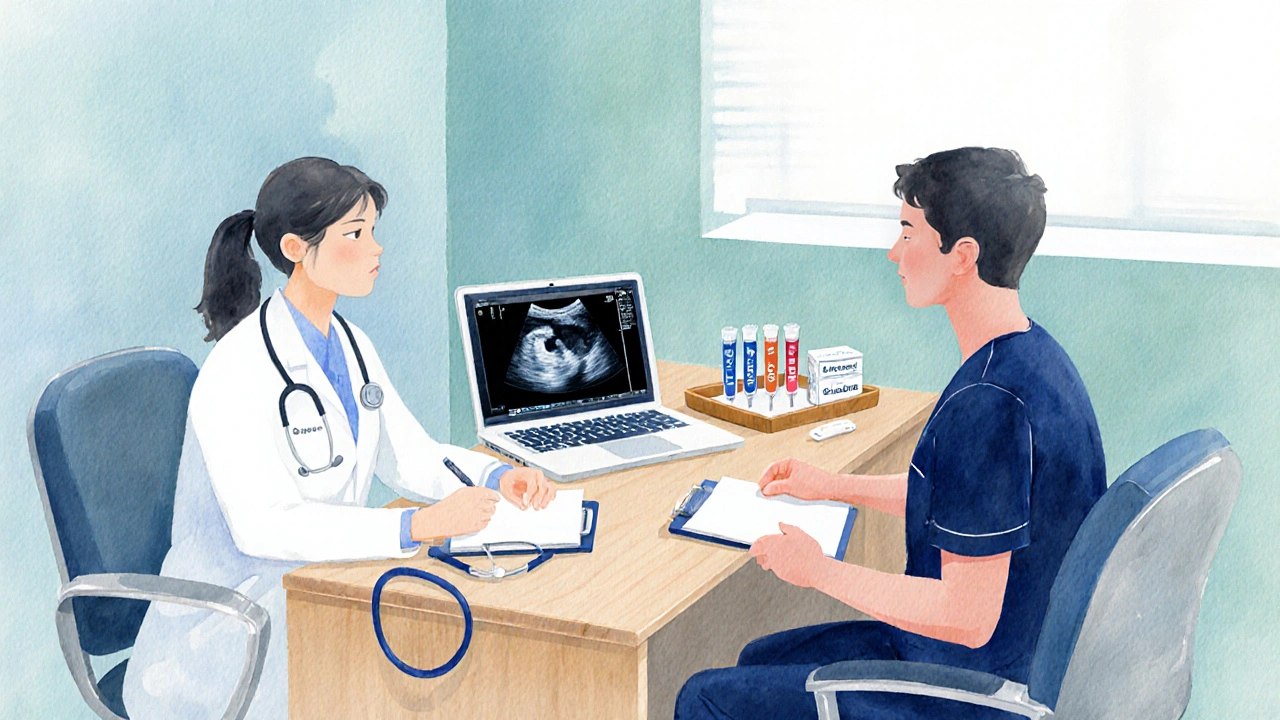
Addison's Disease & Pregnancy Dosage Calculator
Dosage Adjustment Calculator
Enter your current hydrocortisone dose and select your current trimester to see the recommended adjustment.
Recommended Dosage Adjustment
Expecting mothers with Addison's disease is a rare endocrine disorder where the adrenal glands produce insufficient cortisol and often aldosterone, leading to fatigue, low blood pressure, and electrolyte imbalances. When you add pregnancy into the mix, the stakes get higher because both the mother and the developing baby rely on stable hormone levels. This guide walks you through the biggest concerns, the day‑to‑day management tricks, and the steps you can take to keep both you and your baby safe.
Why Pregnancy Changes the Game
During a normal pregnancy, the placenta starts producing hormones like cortisol that help support fetal growth and adapt the mother's metabolism. Those extra hormones mean your usual Addison’s medication dose may no longer be enough. In the second and third trimesters, many women need a 20-40% increase in glucocorticoid replacement to mimic the natural rise in cortisol.
At the same time, the growing uterus can compress your adrenal veins, making blood pressure swings more pronounced. If you miss a dose or face an infection, the risk of an adrenal crisis spikes dramatically, which can threaten both you and the baby.
Team Up With the Right Specialists
Managing Addison’s while pregnant isn’t a solo sport. You’ll want an obstetrician who is comfortable with high‑risk pregnancies and an endocrine specialist skilled in adjusting hormone therapy.
Make sure both doctors share medical records and agree on a monitoring schedule. Regular blood tests for sodium, potassium, and glucose help catch imbalances before they become emergencies.
Medication Management: Dosage Adjustments by Trimester
Most women with Addison’s take hydrocortisone as the main glucocorticoid replacement, along with a mineralocorticoid like fludrocortisone. Below is a quick reference most clinicians use to tweak doses as pregnancy progresses.
| Trimester | Typical Increase | Example Daily Dose | Key Monitoring Points |
|---|---|---|---|
| First (0-13 weeks) | 10-20% | From 20mg → 22-24mg split 2‑3 times | Blood pressure, weight gain |
| Second (14-27 weeks) | 20-30% | From 24mg → 28-30mg split 2‑3 times | Electrolytes, glucose tolerance |
| Third (28+ weeks) | 30-40% | From 30mg → 36-42mg split 2‑3 times | Fetal growth ultrasound, edema |
Fludrocortisone may need a modest boost (often 0.05mg) in the second half of pregnancy to counteract the extra fluid volume. Always discuss changes with your endocrine doctor before making any adjustments on your own.

Spotting the Early Signs of an Adrenal Crisis
Even with perfect dosing, infections, vomiting, or severe stress can trigger a crisis. Keep an eye out for these red flags:
- Sudden, severe weakness or dizziness
- Profound low blood pressure (feeling faint when standing)
- Severe abdominal pain or vomiting
- Confusion or loss of consciousness
If any of these appear, treat it as an emergency. Injectable hydrocortisone sodium succinate (often sold as Solu‑Cortef®) is the first‑line rescue. Your obstetrician should prescribe a pre‑filled emergency kit and teach you and your partner how to use it.
Planning for Labor, Delivery, and the Immediate Post‑Partum Period
Labor is a major stress event, so steroid coverage must be stepped up. Most protocols recommend doubling the usual hydrocortisone dose at the onset of active labor and continuing the higher dose through the first 24hours after birth.
During a vaginal delivery, an IV line with a bolus of 100mg hydrocortisone, followed by a maintenance infusion of 200mg/24h, is common. For a C‑section, the same bolus is given before anesthesia, then the infusion continues.
After delivery, hormone needs usually drop back to pre‑pregnancy levels within a week, but monitor closely for postpartum thyroiditis-a condition that can mimic Addison’s symptoms. Keep your endocrine doctor in the loop for a smooth taper.
Breastfeeding and Medication Safety
Hydrocortisone passes into breast milk in tiny amounts-generally considered safe for most infants. The typical dose (20-40mg/day) results in less than 0.1mg of cortisol per 100mL of milk, far below the infant’s natural production.
Fludrocortisone is also excreted minimally, but if your baby shows signs of excess salt loss (poor weight gain, excessive crying), discuss a possible short‑term dose reduction with your doctor.

Common Myths and Misconceptions
Myth: You must avoid pregnancy if you have Addison’s disease.
Reality: With proper endocrine care, most women have healthy pregnancies and babies.
Myth: All stress hormones are the same, so you can swap medications.
Reality: Hydrocortisone mimics cortisol’s natural rhythm; alternatives like prednisone can cause growth restriction in the fetus.
Myth: Once you’re pregnant, you can skip your daily meds because the placenta will produce enough hormones.
Reality: The placenta’s cortisol cannot fully replace the missing adrenal output, especially during stress.
Checklist for Expecting Moms with Addison’s Disease
- Schedule a joint appointment with your obstetrician and endocrine specialist before conception.
- Carry an emergency hydrocortisone injection kit at all times.
- Update your medication doses each trimester based on your doctor's recommendations.
- Monitor blood pressure, electrolytes, and glucose weekly after the first trimester.
- Discuss a birth plan that includes steroid stress dosing for labor.
- Plan for postpartum follow‑up within one week of delivery.
- Keep a breastfeeding log to track infant weight and any signs of adrenal insufficiency.
Frequently Asked Questions
Can I get pregnant naturally, or do I need IVF?
Most women with well‑controlled Addison’s can conceive naturally. IVF is only considered if there are additional fertility issues unrelated to adrenal function.
What should I do if I vomit and can’t keep my pills down?
Take your emergency hydrocortisone injection immediately (100mg IM), then call emergency services. After the injection, you’ll likely be taken to the hospital for IV steroid replacement.
Is it safe to travel during pregnancy with Addison’s?
Yes, as long as you bring your medication, a copy of your endocrine notes, and an extra emergency kit. Stay hydrated, avoid heat exhaustion, and keep your stress‑dose schedule handy.
Will my baby be born with Addison’s disease?
Addison’s is not usually inherited in a simple dominant way. The risk of a child developing primary adrenal insufficiency is low, but a family history should be discussed with a genetic counselor.
Can I take other vitamins or supplements?
Prenatal vitamins are encouraged, but avoid high‑dose vitaminC or large amounts of potassium without doctor approval, as they can affect blood pressure and electrolyte balance.

AnGeL Zamorano Orozco
October 9, 2025 AT 15:13OMG thsi thing is like a rollercoaster of emotions!! I swear the calculator spawns more drama than my teen years, and the numbers keep dancing like they're on a disco floor. Why does my hydrocortison dose feel like a mystery novel? Every trimester twist makes me want to scream at the screen. The UI glows like a neon sign in the middle of the night and I can't help but think it's mocking me. Seriously, who designed this thing? The instructions are as clear as mud. My heart is pounding just looking at the suggested adjustments!!!
Cynthia Petersen
October 15, 2025 AT 06:46Wow, a dosage calculator for Addison's-because we all needed another thing to double‑check on a coffee‑filled morning. Sure, just plug in your numbers and hope the magic math doesn't send you spiraling. At least the design is sleek enough to distract from the underlying stress. #blessed
Marcia Hayes
October 21, 2025 AT 01:40Congrats on finding a tool that actually cares about your dosage!
Danielle de Oliveira Rosa
October 26, 2025 AT 20:33I understand how unsettling it can feel to navigate hormone adjustments during pregnancy. The calculator provides a helpful baseline, but always cross‑check with your endocrinologist. Each trimester brings its own physiological nuances, which deserve careful monitoring. Remember to track symptoms like fatigue, salt cravings, and blood pressure. Ultimately, personalized medical guidance remains irreplaceable.
Tarun Rajput
November 1, 2025 AT 15:26Pregnancy in the context of Addison’s disease presents a uniquely intricate clinical scenario, one that merits both meticulous attention and compassionate consideration.
The physiologic rise in cortisol‑binding globulin inevitably alters the pharmacokinetics of hydrocortisone, necessitating dose recalibration.
First‑trimester management often involves a modest increase of 2‑5 mg to accommodate expanding plasma volume.
Second‑trimester adjustments may be more pronounced, reflecting heightened metabolic demands and placental conversion of cortisone.
By the third trimester, many clinicians advocate an additional 10‑20 mg increment, though individual response varies.
It is crucial to monitor for signs of over‑replacement, such as excessive weight gain, facial rounding, and hyperglycemia.
Conversely, under‑replacement manifests as persistent fatigue, orthostatic hypotension, and salt cravings.
Regular clinical assessments, including serum electrolytes and blood pressure checks, provide objective data to fine‑tune therapy.
Patient education remains paramount; expectant mothers should be instructed on stress‑dosing protocols for illness or surgical procedures.
A personalized written plan detailing emergency hydrocortisone dosing can avert adrenal crises.
Collaboration between obstetricians, endocrinologists, and primary care providers fosters a cohesive approach to maternal‑fetal health.
Moreover, the psychosocial dimension cannot be overlooked-support networks and mental‑health resources bolster resilience.
Nutritional considerations, such as adequate sodium intake and balanced macronutrients, further support endocrine stability.
While the online calculator offers a convenient starting point, it cannot substitute for professional clinical judgment.
Future research may elucidate optimal dosing algorithms, but until then, clinicians must rely on a blend of evidence‑based guidelines and patient‑specific observations.
In summary, thoughtful dose titration, vigilant monitoring, and interdisciplinary communication collectively safeguard both mother and child throughout this remarkable journey.
Joe Evans
November 7, 2025 AT 10:20😂, wow, that calculator sure looks sleek, but also kinda scary, right?, especially when you’re juggling morning sickness, prenatal vitamins, and a whole lot of worries, but hey, at least it’s there to give you a quick peek, and you can always double‑check with your doc, lol! 😅
Colin Boyd
November 13, 2025 AT 05:13While the calculator is visually appealing it does not replace thorough endocrine evaluation nor does it address individual variability across trimesters
John Petter
November 19, 2025 AT 00:06Indeed, one must rely on seasoned clinical expertise rather than a generic web tool
Annie Tian
November 24, 2025 AT 19:00What a wonderful initiative!! The dosage calculator is a valuable resource, especially for those navigating Addison’s disease during pregnancy, and it serves as an excellent complement to professional medical advice!!
April Knof
November 30, 2025 AT 13:53In many cultures, pregnancy is accompanied by traditional dietary practices that can influence hormone levels; it’s fascinating to see modern tools like this calculator blending with age‑old wisdom to support expectant mothers worldwide.
Tina Johnson
December 6, 2025 AT 08:46While cultural practices are interesting, they often lack scientific backing and can even interfere with proper hydrocortisone management; thus, reliance on anecdotal advice should be approached with caution.